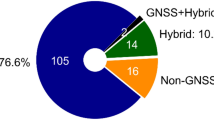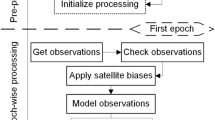Abstract
By introducing the auxiliary variable with respect to the reduced latitude, a new closed-form method for transforming Cartesian to geodetic coordinates has been proposed based on the solution of a special constructed unary quartic equation. The algorithm comes with rigorous and concise procedure of root-finding. Moreover, through theoretical analysis, different approaches with respective pros and cons to determine the geodetic latitude and height have been explored. Besides fast computation, numerical experiments covering the magnitude of the geodetic height from \(- 6.33 \times 10^{6} {\text{m}}\) to \(10^{10} {\text{m}}\) have also shown that the new method can be operational with high precision at almost any point including the region near or at the pole, the equator and the center of the reference ellipsoid. Considering the accuracy, efficiency and adaptability simultaneously, it is prospective to be applied into computation and inspection on critical occasions in comparison to existing methods.




Similar content being viewed by others
Data availability
The data used in this paper are theoretical but of practical significance, which can be generated by computers directly without need of any link or permission.
References
Borkowski KM (1987) Transformation of geocentric to geodetic coordinates without approximations. Astrophy Space Sci 139:1–4
Borkowski KM (1989) Accurate algorithms to transform geocentric to geodetic coordinates. Bull Geod 63:50–56
Bowring BR (1976) Transformation from spatial to geographical coordinates. Surv Rev 23(181):323–327
Bowring BR (1985) The accuracy of geodetic latitude and height equations. Surv Rev 28(218):202–206
Cardanus H (1545) Artis magnae, sive de regulis algebraicis. Pavia, pp 294
Featherstone WE, Claessens SJ (2008) Closed-form transformation between geodetic and ellipsoidal coordinates. Stud Geophys Geod 52:12
Feltens J (2008) Vector methods to compute azimuth, elevation, ellipsoidal normal, and the Cartesian (X, Y, Z) to geodetic (φ, λ, h) transformation. J Geod 82:493–504
Fukushima T (1999) Fast transform from geocentric to geodetic coordinates. J Geod 73:603–610
Fukushima T (2006) Transformation from Cartesian to geodetic coordinates accelerated by Halley’s method. J Geod 79:689–693
Guo JC, Shen WB (2023) A new algebraic solution for transforming Cartesian to geodetic coordinates. Surv Rev 55(389):169–177
Guo JC, Zhao XX, Wu YL (2014) Transformation from Cartesian to geodetic coordinates using Lagrange inversion theorem. Acta Geodaetica Et Cartographica Sinica 43(10):998–1004
Moritz H (2000) Geodetic reference system 1980. J Geod 74:128–133
Turner JD (2009) A non-iterative and non-singular perturbation solution for transforming Cartesian to geodetic coordinates. J Geod 83:139–145
Vermeille H (2004) Computing geodetic coordinates from geocentric coordinates. J Geod 78:94–95
Vermeille H (2011) An analytical method to transform geocentric into geodetic coordinates. J Geod 85:105–117
Acknowledgements
This paper was supported by the National Natural Science Foundation of China (Grant No. 41374042). Last, I thank my previous teacher, Mr. Zhiping Lv, for the impartation of relevant basic knowledge to former me.
Author information
Authors and Affiliations
Contributions
WQ came up with the idea and accomplished the whole research, tests and writing of the paper; JZ supported the work in life.
Corresponding author
Appendices
Appendix 1: Steps of the new algorithm
Step 1: Prepare the initialized constants and variables
Step 2: Distinguish the applicable zone
If \( p^{3} + q\geqslant 0, \)
And unless near the astroid, it can be accelerated with only one cubic root operation as
Otherwise,
To reduce operations of one division and one square root, use
Step 3: Compute the intermediate variables
Step 4: Compute geodetic coordinates \(\left( {\lambda ,\;\varphi ,\;h} \right)\)
If \(t > 0\) or \(n > 0, \)
where the function \(y = {\text{msign}}\left( x \right)\) returns \(1\) when the argument is greater than or equal to zero, and \(- 1\) when the argument is negative.
Unless on a sphere (\(e^{2} \ne 0\)), the computation for \(h\) can be accelerated with one square root operation reduced via
Step 5: Compute geodetic coordinates \(\left( {\lambda ,\;\varphi ,\;h} \right)\) on Singular Line (\(t = n = 0\))
Appendix 2: Particular deficiency of Vermeille’s algorithm
In the computational procedure of Vermeille (2011), for points \(\left( {0, \pm {{ae^{2} } \mathord{\left/ {\vphantom {{ae^{2} } {\sqrt {1 - e^{2} } }}} \right. \kern-0pt} {\sqrt {1 - e^{2} } }}} \right)\), which are two vertexes of the astroid resulting in \(r=p=8r^{3} + e^{4} pq=0\), the equation chosen to compute \(u\) should be the one applied inside the evolute. To ensure the consistent correctness, \({\text{atan2}}\left( {\sqrt {e^{4} pq} ,\;\sqrt { - 8r^{3} - e^{4} pq} + \sqrt { - 8r^{3} } } \right)\) (the sequence of arguments may be opposite in some programming environment) ought to be adopted rather than \({\text{atan}}\left( {{{\sqrt {e^{4} pq} } \mathord{\left/ {\vphantom {{\sqrt {e^{4} pq} } {\left( {\sqrt { - 8r^{3} - e^{4} pq} + \sqrt { - 8r^{3} } } \right)}}} \right. \kern-0pt} {\left( {\sqrt { - 8r^{3} - e^{4} pq} + \sqrt { - 8r^{3} } } \right)}}} \right)\), which will make the operating speed of computing other points decreased meaninglessly. Crucially, the result of arctangent function with two parameters both equal to zero is still indeterminate in some programming environment such as \({\text{ArcTan}}\left[ {0,\;0} \right]\) in Mathematica.
Appendix 3: Usability problems of the algorithm by Guo and Shen
The main variable in the closed-form method by Guo and Shen (2023) is also relative to the reduced latitude, but some hidden troubles should be noticed except that the speed is slower than the method by Vermeille (2011) which was confirmed in their paper (2023, pp. 173 ~ 174). Primarily, the first eccentricity squared \(e^{2}\) at denominators of some equations (2023, Eqs. (A10) and (A11)) makes that algorithm lose effect when the geodetic model is a sphere (\(e = 0\)). More seriously, significant digit loss will happen at the time of the subtraction between two close values (2023, e.g., the first and fourth items of equation group (A11)), which can be easily checked by two numerical examples:
(a) when φ = 89.999992°, h = 3.02 × 107m, the error of recovered latitude will reach 1.58 × 10−9rad (about 0.003″). This makes about 0.06m bias in the equatorial direction;
(b) when φ = 47, h = − 6.34681246356 × 106m, it will increase to 1.81 × 10−6rad (about 0.37″).
These degrees of errors cannot be accepted, and the method should be used prudentially.
Rights and permissions
Springer Nature or its licensor (e.g. a society or other partner) holds exclusive rights to this article under a publishing agreement with the author(s) or other rightsholder(s); author self-archiving of the accepted manuscript version of this article is solely governed by the terms of such publishing agreement and applicable law.
About this article
Cite this article
Quan, W., Zhang, J. A complete closed-form method for transformation from Cartesian to geodetic coordinates. J Geod 98, 19 (2024). https://doi.org/10.1007/s00190-024-01821-w
Received:
Accepted:
Published:
DOI: https://doi.org/10.1007/s00190-024-01821-w




